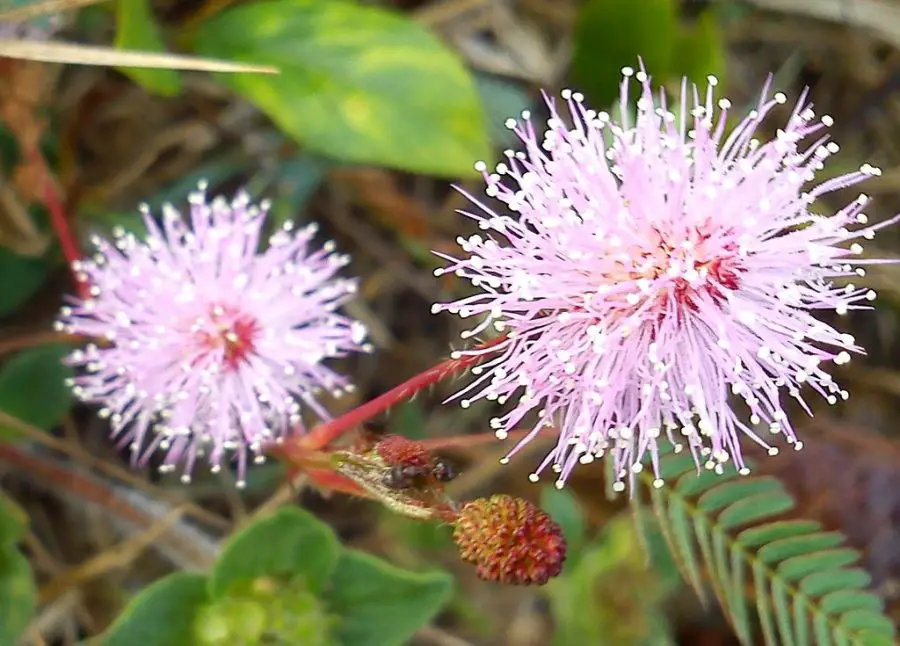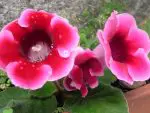This post contains affiliate links. If you buy something from one of our links we may earn a commission. Thanks

Discover how to keep the fascinating sensitive plant healthy and thriving indoors! Our guide to sensitive plant care indoors has got you covered.
To care for Sensitive Plant or Mimosa Pudica, place it in a sunny location and keep the soil consistently moist but not waterlogged. This plant thrives in well-drained soil and prefers a humid environment. Fertilize sparingly during the growing season and avoid touching the leaves excessively to keep it healthy.
Are you looking for a unique and intriguing plant to add to your indoor collection? Look no further than the sensitive plant!
With its fascinating ability to fold its leaves inward when touched, the sensitive plant is sure to spark curiosity and conversation.
But how do you care for this delicate plant indoors? In this guide to sensitive plant care indoors, we’ll cover everything you need to know to keep your sensitive plant healthy and thriving. Let’s dive in!
An Introduction To Sensitive Plant Care Indoors
Hey there, fellow plant enthusiasts! Are you in search of a captivating and interactive plant to add to your indoor garden?
Then say hello to the Mimosa Pudica, also known as the sensitive plant. According to Wikipedia:
Mimosa pudica (from Latin pudica ‘shy, bashful, or shrinking’; also called sensitive plant, sleepy plant, action plant, touch-me-not, or shameplant is a creeping annual or perennial flowering plant of the pea/legume family Fabaceae.
It is often grown for its curiosity value: the sensitive compound leaves fold inward and droop when touched or shaken and re-open a few minutes later. Mimosa pudica is not a carnivorous plant.
This unique plant is sure to catch your attention with its fascinating ability to fold its leaves inward when touched, making it a favorite among kids and adults alike.
But how can you ensure that this sensitive plant thrives in the indoor environment?
In this guide, we’ll walk you through all the tips and tricks for sensitive plant care indoors, so you can enjoy this captivating plant for years to come. Let’s get started!
The unique Mimosa Pudica
Mimosa Pudica, also known as the sensitive plant, is a fascinating plant that belongs to the pea/legume family Fabaceae.
Native to Central and South America, it is known for its unique ability to close its leaves when touched, making it a popular addition to indoor gardens.
Its unique movements have made it a favorite among botanists and plant lovers worldwide.
Why we’re here
In this blog post, we will be discussing sensitive plant care indoors and the best ways to care for Mimosa Pudica indoors.
We want to help you understand the needs of this plant and how to propagate, transplant, and care for it so that it can thrive in an indoor environment.
By the end of this post, you will have all the knowledge you need to grow and maintain a healthy and happy Mimosa Pudica.
Overview of the topics
Throughout this post, we’ll cover a variety of topics to ensure that your sensitive plant thrives in your home.
We’ll start by discussing the unique needs of Mimosa Pudica, including light requirements, temperature and humidity preferences, watering needs, soil requirements, and nutrient requirements.
Then, we’ll dive into propagation techniques, such as propagation by seeds and cuttings.
Next, we’ll explore the process of transplanting and the best techniques to follow to ensure a successful transplant.
We’ll also provide you with tips on how to care for your sensitive plant, including watering and fertilization, pruning and shaping, pest and disease prevention and treatment, and winter care.
By the end of this post, you’ll be confident in your ability to care for your sensitive plant indoors.
Understanding the Needs of Mimosa Pudica
To care for your sensitive plant properly, you need to understand its unique needs. So, let’s get started by exploring what makes Mimosa Pudica tick!
The plant’s light requirements are crucial to its survival, as it needs a good balance of light and shade.
Temperature and humidity preferences also play a significant role, as the sensitive plant needs a warm and humid environment to thrive.
We’ll also delve into its watering needs, soil requirements, and nutrient requirements, so you can provide your sensitive plant with the ideal conditions for growth.
By the end of this section, you’ll have all the information you need to create the perfect environment for your sensitive plant.
Light requirements:
The sensitive plant needs a good balance of light and shade to thrive. It is not tolerant of direct sunlight, so placing it in a bright but shaded area is ideal.
East-facing windows are a great option, as they provide plenty of morning light while avoiding the harsh afternoon sun.
If you notice your plant becoming leggy or losing its vibrant color, it may not be getting enough light, so adjust its placement accordingly.
Temperature and humidity preferences:
Temperature and humidity play a significant role in the sensitive plant’s growth and development.
This plant prefers warm temperatures ranging from 60°F to 85°F (15°C to 29°C) and high humidity levels of at least 60%.
To maintain proper humidity levels, mist the plant regularly or use a humidifier near the plant.
Keep in mind that drafty areas can harm the sensitive plant, so keep it away from doors, windows, and air conditioning vents.
Watering needs:
Watering your sensitive plant correctly is crucial to its survival. Overwatering can lead to root rot, while underwatering can cause the plant to wilt and dry out.
The best way to ensure that your plant is getting enough water is to feel the top inch of the soil.
If it feels dry, it’s time to water. Be sure to use room temperature water and avoid getting water on the leaves, as this can cause them to droop.
Soil requirements:
Sensitive plants prefer well-draining soil that is rich in organic matter. A mix of potting soil and perlite or sand is ideal.
Coco coir and perlite also make a good potting mix and are a more environmentally friendly choice to peat moss based soil products.
Ensure that the pot has adequate drainage holes to avoid waterlogging the soil, which can lead to root rot.
Nutrient requirements:
Sensitive plants have moderate nutrient requirements, and overfertilizing can harm them.
A balanced, water-soluble fertilizer is ideal, and it’s best to avoid fertilizing during the winter months when growth is slower.
Be sure to follow the manufacturer’s instructions when applying fertilizer, and remember that less is more when it comes to feeding your sensitive plant.
Propagation of Mimosa Pudica
If you’re looking to expand your collection of sensitive plants, propagation is a great way to do it!
Propagation involves creating new plants from existing ones, and it’s easier than you might think.
In this section, we’ll explore two common propagation techniques for Mimosa Pudica: propagation by seeds and propagation by cuttings.
We’ll cover everything you need to know to successfully propagate your sensitive plant, so you can grow your collection with ease. So, grab your gardening gloves, and let’s get started!
Propagation by seeds:
Propagating Mimosa Pudica by seeds is a simple and straightforward process.
Begin by collecting the seeds from the plant’s dried pods, which should be done when they turn brown and begin to split open.
Soak the seeds in warm water overnight, which will help soften the hard seed coat and encourage germination.
Next, plant the seeds in a seed-starting mix, lightly cover them with soil, and water them gently.
Keep the soil moist and warm, and within two to four weeks, your seeds will begin to sprout.
Propagation by cuttings:
Propagating Mimosa Pudica by cuttings is an easy and reliable way to produce new plants quickly.
To do this, start by taking a 3-4 inch cutting from a healthy plant, making sure that it has at least one leaf node.
Remove the lower leaves from the cutting and dip the cut end into rooting hormone powder.
Plant the cutting into a small pot filled with moist soil, covering the leaf node with soil.
Keep the soil moist and warm, and within two to four weeks, your cutting should develop roots and start to grow.
Once the plant has established roots, it can be transplanted into a larger pot.
Transplanting Mimosa Pudica
As your sensitive plant grows, it will eventually need more space to thrive, and that’s where transplanting comes in.
Transplanting involves moving your plant into a larger pot or container, providing it with more room to grow and access fresh nutrients.
However, transplanting can be a delicate process, and it’s essential to do it correctly to avoid damaging the plant.
In this section, we’ll provide you with tips and techniques to help you successfully transplant your sensitive plant, so you can watch it continue to thrive and grow. Let’s get started!
Selecting a pot:
Choosing the right pot for your sensitive plant is crucial to its health and well-being.
Select a pot that is one size larger than the current one, with good drainage holes at the bottom.
Avoid pots that are too big, as excess soil can hold too much moisture and harm the roots.
It’s also essential to choose a pot that matches your decor and style, as this will help make your sensitive plant a focal point in your indoor garden.
Preparing the potting mix:
Before transplanting your sensitive plant, you’ll need to prepare the potting mix.
A high-quality potting soil mixed with perlite and coco coir, or peat moss will provide good drainage and aeration for your plant’s roots.
Be sure to moisten the potting mix before adding it to the new pot, as this will help prevent the soil from becoming too compacted and make it easier for your sensitive plant to establish itself in its new home.
Repotting techniques:
When it comes to repotting your sensitive plant, there are a few essential techniques to keep in mind.
Gently remove the plant from its old pot, being careful not to damage the roots. If the roots are tightly wound, you may need to loosen them a bit before placing the plant into the new pot.
Next, place the plant into the new pot, ensuring that it sits at the same depth as in the old pot.
Add the potting mix around the root ball, gently pressing it down to remove any air pockets.
Water the plant thoroughly, ensuring that the soil is moist but not waterlogged.
Finally, place the plant in a warm, bright area and continue to care for it as usual.
Caring for Mimosa Pudica
Congratulations, you’ve successfully transplanted your sensitive plant into its new home! Now it’s time to focus on the ongoing care of your plant.
To keep your Mimosa Pudica healthy and happy, you’ll need to provide it with regular watering, fertilization, pruning, and pest control.
In this section, we’ll provide you with tips and techniques to help you care for your sensitive plant, so you can watch it continue to thrive and flourish.
So, let’s get started on how to care for your sensitive plant indoors!
Watering and fertilization:
Watering your sensitive plant correctly is crucial to its survival. Overwatering can lead to root rot, while underwatering can cause the plant to wilt and dry out.
Water your plant when the top inch of soil feels dry, using room temperature water to avoid shocking the plant.
Fertilize your plant with a balanced, water-soluble fertilizer every two to four weeks during the growing season, following the manufacturer’s instructions.
Avoid fertilizing during the winter months when growth is slower.
Pruning and shaping:
Pruning your sensitive plant can help control its growth and encourage bushiness.
Prune your plant regularly, removing any dead, yellow, or diseased leaves.
Pinch off the tips of young shoots to encourage branching and shape the plant as desired.
Be sure to sterilize your pruning tools between uses to prevent the spread of disease.
Preventing and treating pests and diseases:
Sensitive plants are susceptible to a variety of pests and diseases, including spider mites, whiteflies, and powdery mildew.
To prevent these issues, keep your plant in a warm, humid environment and avoid overwatering.
If you do notice pests or diseases on your plant, treat it immediately with a natural or chemical pesticide or fungicide, following the manufacturer’s instructions.
In most cases using insecticidal soap or neem oil will take care of most pest problems.
Winter care:
During the winter months, the growth of your sensitive plant may slow down, and it may require less frequent watering and fertilization.
Reduce watering to once every two weeks or when the top inch of soil feels dry, and avoid fertilizing during this time.
Keep the plant away from drafty areas and ensure that the temperature does not drop below 60°F (15°C).
Sensitive Plant Care FAQs
Sensitive plants, also known as Mimosa Pudica, are fascinating flora known for their unique leaf-folding reaction when touched.
Their sensitivity to touch has made them quite popular, but caring for them involves more than just observing their intriguing movements.
To keep your sensitive plant healthy and flourishing indoors, there are a few key considerations such as sunlight, watering, and the potential risks of frequent touching.
Here are some frequently asked questions to guide you in providing the best care for your sensitive plant.
Q: How do you take care of a sensitive plant indoors?
A: Keep the plant in a sunny spot and ensure the soil is well-drained but consistently moist.
Use a humidifier or a tray filled with water and pebbles to increase humidity.
Q: Does sensitive plant need sun?
A: Yes, sensitive plants thrive in bright, indirect sunlight. Place them near a window but not in direct, harsh sunlight to prevent leaf burn.
Q: Should I mist my sensitive plant?
A: Misting can help maintain humidity, which the sensitive plant enjoys.
However, over-misting can lead to mold and other issues, so proceed cautiously.
Q: Why shouldn’t you touch a sensitive plant often?
A: Frequent touching can cause stress to the plant and may weaken it over time. While the leaf-folding mechanism is fascinating, it’s best to limit how often you trigger it.
Sensitive Plant Care Indoors Final Thoughts
Congratulations, you’ve made it to the end of our guide to sensitive plant care indoors!
By now, you should have a good understanding of what makes this plant unique and how to care for it in your home.
We’ve covered everything from the plant’s light and humidity requirements to propagation and transplanting techniques, as well as ongoing care tips such as pruning, pest control, and winter care.
By following these tips and techniques, you’ll be able to grow a healthy and vibrant Mimosa Pudica in your indoor garden.
We hope you’ve found this guide helpful and that your sensitive plant brings you joy and beauty for years to come.
Recap Of Key Points For Sensitive Plant Care Indoors:
Before we wrap up, let’s quickly recap the key points of this guide to sensitive plant care indoors.
We’ve covered the plant’s unique characteristics, such as its light and humidity requirements and its rapid plant movement.
We’ve also explored propagation and transplanting techniques, ongoing care tips such as pruning and pest control, and winter care advice.
By following these tips and techniques, you’ll be well on your way to growing a healthy and vibrant Mimosa Pudica in your indoor garden.
Final tips for success with Mimosa Pudica Indoor Care:
As a final word of advice, here are a few extra tips to help you succeed with your sensitive plant.
Be patient, as Mimosa Pudica can be slow to grow and establish itself.
Be observant, as this plant can be quite sensitive to changes in its environment, and adjusting its care as needed can help it thrive.
Finally, don’t be afraid to experiment with different techniques, such as air-layering or different types of fertilizers, to find what works best for your plant and your growing conditions.
Encouragement to share experiences with growing Mimosa Pudica:
Growing plants can be a rewarding and fulfilling experience, and we encourage you to share your experiences with growing Mimosa Pudica with others.
Whether it’s sharing photos of your plants on social media, participating in online plant groups, or simply chatting with fellow plant enthusiasts.
Sharing your love of this unique and fascinating plant can help connect you with a like-minded community.
So, don’t be shy, share your love of Mimosa Pudica with the world!
Not sure if keeping houseplants is your cup of tea? Read more about the Benefits Of Keeping Indoor Plants












